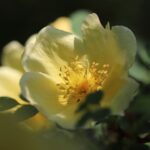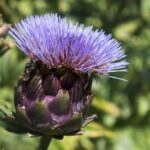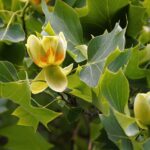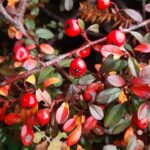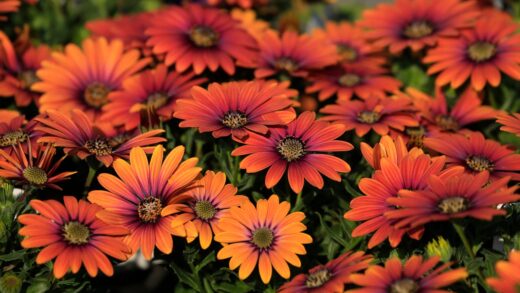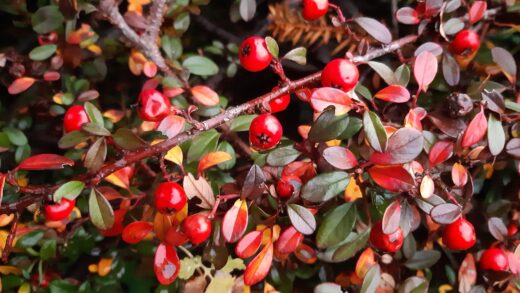The golden rose, scientifically known as Rosa xanthina, is a breathtakingly beautiful shrub native to northern China and Korea, serving as one of the earliest and most spectacular harbingers of spring in the garden. This variety is not one of the modern, highly-bred roses but a species rose that has retained its natural charm and resilience. Its vibrant yellow, cup-shaped flowers densely cover the gracefully arching branches long before most other rose varieties even begin to form buds. Its significance lies not only in its early bloom but also in being an exceptionally rewarding ornamental plant that requires relatively little care, offering a sense of achievement even for novice gardeners.
In terms of appearance, it is a medium to large deciduous shrub that can easily reach a height and spread of 2-3 meters. Its canes are thin, reddish-brown, and densely covered with small but sharp prickles. The foliage also has special ornamental value; the leaves are pinnately compound, composed of small leaflets with a fine, almost fern-like texture. The flowers are typically single-petaled, 4-5 cm in diameter, and shine in a brilliant, pure yellow color, almost completely obscuring the foliage at the peak of bloom.
It is important to distinguish the true Rosa xanthina species from the more commonly available ‘Canary Bird’ hybrid in nurseries. Although ‘Canary Bird’ has Rosa xanthina as one of its parents (the other being Rosa hugonis) and is remarkably similar in appearance, its flowers can be slightly larger and fuller. However, their care requirements are almost identical, so the advice given in this article is perfectly applicable to both plants. Despite the popularity of ‘Canary Bird’, it is worth seeking out the base species if you want a truly authentic, natural-looking shrub in your garden.
From a landscaping perspective, the golden rose is extremely versatile. Due to its impressive size and early flowering, it is excellent as a specimen plant where its full beauty can be admired. It also looks wonderful in the background of mixed shrub borders, where it takes center stage in spring and provides a discreet backdrop with its fine-textured foliage for the rest of the season. It can also be planted as a loose, unpruned hedge, which is not only decorative but also serves an effective protective function thanks to its thorns, while attracting pollinators like bees.
Choosing the right location and planting
The absolute key to the abundant flowering and healthy development of the golden rose is providing an adequate amount of sunlight. This plant is decidedly sun-loving, so a spot in the garden that receives at least six, but preferably eight, hours of direct sunlight daily must be found for it. In shadier conditions, the shrub will survive, but its growth will be weaker and lankier, and its flowering will be significantly reduced or may not occur at all. A south or southwest-facing position is ideal, where it is exposed to the sun’s rays for the longest period.
Regarding the soil, the most important aspect is good drainage. The golden rose, like most rose varieties, does not tolerate waterlogging, which leads to root rot and the plant’s demise. The ideal soil is a structurally loose, nutrient-rich loam with a slightly acidic to neutral pH, meaning a pH value between 6.0 and 7.0. If the garden soil is too heavy and clayey, its structure must be improved before planting by incorporating well-rotted compost, sand, or other loosening materials.
The most favorable time for planting is in the autumn or early spring when the plant is dormant. Be generous when digging the planting hole: it should be at least twice as wide and deep as the plant’s root ball or container. It is a good idea to place a layer of organic manure or compost at the bottom of the hole, then cover it with a thin layer of soil so that the roots do not come into direct contact with the concentrated nutrients. Place the plant in the hole so that the root collar is level with the soil surface, then backfill with the excavated soil and water thoroughly.
Spacing and proper placement will determine the shrub’s long-term health. As it is a large, spreading bush, allow it ample space, at least 2-2.5 meters in all directions from other plants or structures. This not only allows the shrub to reach its full, natural size and shape but also ensures proper air circulation around the foliage. Good air movement is essential for preventing fungal diseases such as powdery mildew or black spot, which thrive in damp, stagnant air environments.
Guide to watering and fertilizing
When it comes to watering the golden rose, the principle of “less frequent but more thorough” is paramount. Instead of shallow, frequent watering, deep watering with larger amounts of water at less frequent intervals is much more beneficial. This encourages the plant to grow its roots deeper into the soil, making it more drought-resistant and more securely anchored. The best way to determine when watering is needed is to stick your finger a few centimeters deep into the soil; if it feels dry there, it’s time for a thorough watering.
Newly planted, young shrubs naturally have a higher water requirement and need regular moisture for the first one or two years to establish properly. However, well-established specimens that have been in place for several years are surprisingly drought-tolerant, thanks to their deep root systems. Nevertheless, they are grateful for supplementary watering during long, dry summer periods, especially in the weeks before and during flowering. Watering should preferably be done in the early morning hours, and the water should be delivered directly to the base of the plant, avoiding wetting the foliage, which could promote the spread of fungal diseases.
In terms of feeding, the golden rose is not a heavy feeder, unlike modern, continuously blooming hybrid teas. Excessive fertilization, especially with high-nitrogen fertilizers, can result in lush, leafy growth at the expense of flowers. It is usually sufficient to apply a dose of a balanced, slow-release rose fertilizer or a good amount of mature compost or well-rotted manure around the base of the plant in early spring, at the time of bud break, and lightly work it into the soil.
Among the essential nutrients, potassium plays a key role in flower production, increasing stem strength, and enhancing disease resistance. Stop fertilizing by mid-summer at the latest to allow the plant time to prepare for the winter dormancy period and for the new shoots to mature. Mulching the soil with materials like pine bark or wood chips not only helps suppress weeds and retain soil moisture but also continuously enriches the soil with nutrients as it slowly decomposes.
The art and techniques of pruning
Pruning the golden rose is fundamentally different from the procedures used for most modern roses familiar to gardeners. The most important thing to know is that this shrub produces its flowers on the previous year’s growth, so-called “old wood.” Consequently, the drastic late-winter or early-spring pruning performed on hybrid teas would be catastrophic for this species: it would remove all the flower buds, and the plant would not bloom that year. Therefore, pruning is not intended to stimulate flowering but to maintain the shrub’s health and shape.
The ideal time to prune is immediately after flowering has finished, in late spring or early summer. This strategic timing allows the plant enough time during the remainder of the growing season to develop new canes on which the flowers will appear the following spring. If this task is postponed until autumn or winter, you risk the next year’s floral display. Timing is therefore critical for successful care.
The main goal of pruning is to maintain a loose, healthy structure for the shrub. First, always remove all dead, damaged, or diseased branches (known in English literature as the “three D’s” rule: dead, damaged, diseased). After that, thin out the bush by cutting out some of the oldest, least productive, thickened canes right at the base (usually a quarter to a fifth of the canes). This process encourages the plant to produce new, vigorous shoots from the base, ensuring the continuous renewal of the shrub.
When shaping the shrub, respect its natural, gracefully arching, fountain-like habit. Avoid drastic cutting back or shearing it into a strict, geometric shape, as this would take away the plant’s main attraction, its natural elegance. If the bush has grown too large, the longest branches can be selectively shortened back to a lateral bud or a junction, but the goal should always be to preserve the natural form. Pruning is therefore more of a fine-tuning than a radical intervention.
Protection against diseases and pests
A welcome characteristic of the golden rose is that, as a species rose, it is significantly more resistant to most rose diseases than modern, over-bred hybrids. This does not mean it is completely immune, only that under proper growing conditions, it rarely becomes seriously ill. The best method of prevention is good cultivation practice: planting in a sunny, airy location, avoiding overwatering, and providing adequate nutrition already significantly reduce the risk of infections.
The most common fungal diseases that may nevertheless appear occasionally are rose powdery mildew and black spot. Powdery mildew forms a white, powdery coating on the leaves and young shoots, while black spot appears as black spots around which the leaf turns yellow and falls off. Both diseases favor humid, warm weather and poor air circulation. The first step in control is the immediate removal and destruction of infected leaves (not throwing them in the compost). For milder infections, sprays based on neem oil or potassium bicarbonate can be effective.
Among pests, aphids can be the most troublesome, especially in spring when they attack fresh, tender shoots and buds. A strong jet of water can be effective against aphid colonies, or in more severe cases, environmentally friendly spraying with potassium soap-based products. Instead of chemical control, it is worth attracting natural enemies like ladybugs into the garden. Less common pests include spider mites (especially in dry, hot weather) or the larvae of rose sawflies, which chew the leaves.
A proactive, preventive strategy is the most effective method of defense. A healthy, well-conditioned plant is its own best defense against diseases and pest attacks. Regularly inspect the bush to detect and treat any potential problems in their early stages. Planting companion plants can also help; for example, the scent of lavender or garlic can deter aphids. Creating a balanced garden ecosystem is the best long-term protection.
Propagation methods
Propagating the golden rose is a rewarding task that allows you to get new plants for free, which you can give away or plant in other parts of your garden. The two most common and easily achievable methods for hobby gardeners are hardwood and softwood cuttings. The essence of both techniques is to root a cut part of the plant, thus creating a new individual that is genetically identical to the mother plant. This is particularly important for the ‘Canary Bird’ hybrid, which does not pass on its characteristic traits when grown from seed.
Softwood cuttings should be taken in late spring or early summer, after flowering. At this time, you should choose fresh shoots that have already hardened somewhat but are still flexible – they snap rather than bend when flexed. Cut a piece about 10-15 cm long, remove the lower leaves, dip the cut surface in rooting hormone, and then stick it into a pot filled with a loose, moist medium (e.g., a mixture of perlite and peat). To ensure high humidity, cover the pot with a clear plastic bag or bottle and keep it in a warm, bright place, but protected from direct sunlight.
Hardwood cuttings are taken during the plant’s dormant season, in late autumn or winter. At this time, you should cut a 20-25 cm long piece from the current year’s fully matured, pencil-thick canes. The bottom end of the cutting should be cut at an angle, just below a bud, and the top end straight, above a bud, so you know which end is up later. The hardwood cuttings can either be stuck directly into a prepared, dug-up bed in a sheltered part of the garden, with only the top one or two buds showing above the ground, or stored in a deep pot with sandy soil until spring.
Other propagation methods exist, although they are less common. Layering is an extremely simple and almost always successful procedure where a low-growing, flexible cane of the shrub is bent down to the ground, secured in one place, and covered with soil while the cane remains attached to the plant. The soil-covered part will root within one or two years and can be separated from the mother plant. Propagation from seed is also possible for the base species, but the seeds need to be cold-stratified, and the process is lengthy, and the resulting seedlings can be variable.
Winter preparation and spring awakening
The golden rose is one of the hardiest rose species, reliably overwintering in most gardens in temperate climates without special winter protection. Generally, it is rated as hardy down to USDA zone 4 (which means extremely cold winters), so typical conditions in many regions pose no challenge for it once the plant is well-established and strengthened. Young, newly planted shrubs may still require some extra attention during their first one or two winters.
The most important steps for winter preparation begin in late summer. At this time, do not give the plant any more nutrients, especially nitrogen-based fertilizers, as this would encourage the growth of new, tender shoots that would not have time to mature before the frosts and would thus be easily damaged by frost. Before the first serious frosts set in, make sure the soil around the base is adequately moist; a final, thorough watering will help the plant get through the winter period.
After the first hard frosts, when the soil surface begins to harden, it is advisable to mound up the base of the shrub, creating a 15-20 cm high hill of soil or compost around its base. Then, cover the area around the base with a thick layer of mulch (leaves, straw, pine bark), which acts as an insulating layer, protecting the root system from extreme temperature fluctuations and deep freezing. In harsher, windier regions, wrapping the canes of young shrubs in burlap might be considered, but for an established, vigorous bush, this is usually unnecessary.
With the arrival of spring, when the danger of hard frosts has passed, the winter protection can be gradually removed. Carefully dismantle the mound of earth around the base and spread out the mulch layer to allow the soil to warm up and breathe. This is the time for a thorough inspection: examine the bush and prune off any branch tips or canes that were damaged, frozen, or broken during the winter, cutting back to a healthy bud. After this, you can apply the first dose of spring fertilizer to give the plant the strength to sprout and for the spectacular flowering that will soon follow.

